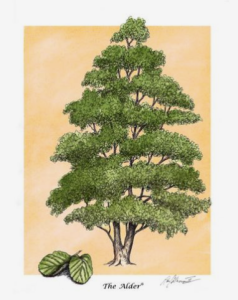PRIESTESS OF AVALON Study
Fire and Water: The Alder Tree

The Alder tree is known as tree of the alder king and elven kind and holds a revered place in folklore and mythology.
Known for its ability to thrive in watery landscapes and transformation to high quality charcoal the alder is a bridge between worlds, embodying the connection between the elements of fire and water, and standing as a symbol of protection, resilience, and transformation.
Herbal knowledge passed down through generations reveals the alder’s medicinal properties. The bark of the alder tree is rich in tannins and has been used traditionally as an astringent and anti-inflammatory remedy. It can be applied to wounds to reduce swelling and promote healing, while a decoction of the bark may be used to soothe sore throats and mouth inflammations. The leaves, when fresh, can be placed in shoes to relieve tired and aching feet, drawing out fatigue and providing a sense of rejuvenation.
Mystically, the alder tree is a symbol of resilience and transformation. Its ability to thrive in wetlands and marshy areas, where few other trees can grow, speaks to its strength and adaptability. In magical practices, the alder is often used in rituals of protection and divination. Its wood is ideal for crafting wands and talismans, believed to enhance spiritual insight and shield the bearer from negative influences.
The alder is also associated with the power of fire, despite its affinity with water. In Celtic tradition, the alder was one of the sacred woods used in the Beltaine fires, symbolizing purification and the rekindling of life’s vital energies. This dual association with both water and fire underscores the alder’s role as a harmonizer of opposites, a tree that embodies the balance and interplay of elemental forces.
In the heart of the forest or by the water’s edge, the alder tree stands as a sentinel and guide, inviting us to explore the mysteries of the natural world and the hidden depths of our own souls. It reminds us of the strength that comes from adaptability, the protection that comes from connection to the land, and the transformative power that lies within us all.


The wood is white and when it is cut or its roots are exposed to the air it turns bright red, alchemical colours. White represents moon and water, Branwen the white raven. Red the sun, fire and Bran the Blessed.
In Celtic mythology, the alder tree is sacred to Bran the Blessed, a giant and king associated with prophecy and the Otherworld. The alder’s association with Bran highlights its role as a protector and guide, a tree that stands at the threshold of realms, guarding the passage between the mortal world and the mystical. The red sap of the alder, which runs like blood when the tree is cut, was believed to be a sign of Bran’s protective presence, lending the tree a sacred and almost magical aura.
Folklore tells of the alder’s ability to resist decay in water, making it a favoured wood for building bridges, boats, and structures in wet environments (its wood gets even harder in water and was used to build cities like Venice) . This quality further enhances its symbolism as a bridge between worlds, both literally and metaphorically. In Irish tradition, the alder is associated with the faeries, particularly water spirits, who are thought to dwell within its groves and protect the tree with their enchantments.
We too are bridges like trees, heaven and earth being bridged through us, our heart. Like the ravens we can receive the messages of the divine and speak them into the human world.

Bran the Blessed, a mythological king – his right to rule given to him by the goddess sovereignty, the embodiment of the land herself – once said: “Who would be a leader must first become a bridge”. And there are many ways to become a bridge. Bridging from external knowing to inner wisdom, from putting trust solely on others to finding trust in oneself. We can learn how to bridge peace from inner conflict resolution to outer solutions. And we constantly bridge throughout our days, we often just don’t realise. We bridge from head to heart, from sacred to mundane. We bridge from Maiden to Mother to Mave and Crone. Even though our western culture has lost the art of initiation and rites of passages of such crucial bridging moments, we have not forgotten them entirely. It is woven in the strings of our DNA, and being kept alive by indigenous communities all across the globe. We simply have to ask the right questions and embark on our quest.
Becoming a priestess is becoming a bridge, bridging from inner conflict resolution to external solutions of regeneration and peace. It involves inner work, reconciliation, tending to conflicting emotions, integrating ones past hurts, wounds and traumas as well as tending to vision, kindling the flame of inspiration, passion and willpower to commit to a new path and keep shining this light on the sign posts forward which we would otherwise overlook.
One essential priestess task which we still know of from pre-christian times – and we really don´t know much as we don´t have many writings on women in sacred power positions, so this seems even more crucial as its mentioned in various sources – is that of a peaceweaver, a messenger of conflict resolution, a bridge between war faring nations and tribes.
Priestesses and groups of women whose tasks seem related to those of druids were called upon amidst the battlefield, stopping fully equipped, ready-to-fight soldiers in their actions by stepping forth and negotiating with seemingly enchanting communication and prophetic skills.
This might not be relevant in its exact form today as war seems to be made in high top buildings amongst rich men with their power and money driven strategies. I believe the modern priestess tends to the battlefield within, holding space for other´s troubles, witnessing their pain and helping them to move through their pain and fear to arrive at their own empowerment. As a guide and vessel of the goddess, she creates an experience of unconditional love that her recipient can´t (yet) fathom for themselves alone.
Sound familiar? You probably experienced something similiar in the presence of cacao, either through your own willingness to go within and surrender yourself to the plants teachings or through the hands of a practitioner … well, let me take you back to the ancient ways of Cacao and why this plant is an incredible ally for inner – and through that inadvertently outer – conflict resolution.
Hence why you can access a cacao ceremony in the next chapter!